Review and images by JimoAi; edited by bmathison1972
Happy Shark Week to everyone who loves sharks! This is the time of year where TV programs go out of their way to showcase shark-based programs, most notably Discovery Channel and National Geographic. These programs help open the doors to knowledge on these animals and help the general public understand, instead of fear, these misunderstood creatures, although some programs may over sensationalize rather than give true facts. Over the years, many companies have produced shark toys and figures of varying quality, which includes sets of miniature tube-sized figures featuring various sharks and sometimes rays; these are great for children as they are mostly inexpensive and introduce them to the various species in an easier way, as well as for collectors who have limited space. The most notable collections in the West are those by K&M International (Wild Republic) and Safari Ltd., both of which are older sets, and the sculpts and paint are not up to today’s standards. Safari’s maintains good in terms of quality as toys, and their more recent TOOBs have seen an improvement in terms of accuracy to the real animals and more detail in sculpt and paint. Today’s subject is the Colorata Sharks of the World set, which was released in 2004 and the Japanese counterpart to the Sharks TOOB of Safari Ltd. This set features 12 figures: 8 sharks and 4 rays, and are about the size of larger TOOB figures like the Safari Ltd.’s Prehistoric Sharks TOOB, and comes packaged in a red tool box-like package with a handle for easier transportation. A disclaimer: I do not have the accompanying box and booklet as I got this set secondhand. This is not the only sharks collection by Colorata; earlier I reviewed the Deluxe Sharks of the World box set.

Without further ado, let’s take a look at the figures in the set in alphabetical order by English name.
Blacktip reef shark (Carcharhinus melanopterus)
Size of figure: 8cm
Size of animal: 91-200 cm for a large female, although normally averages around 160 cm
Scale: 1:11.5-1:25
Species frequency in being made: rare
Preferred habitat: Coral reefs but may enter brackish and freshwater
Diet: fish, mollusks and crustaceans:
IUCN status: Vulnerable
Among the most common shark in captivity due to its relatively small size and typical shark like body plan, the blacktip reef shark is a popular species both in larger private and public aquariums. The figure is painted in a brownish grey with 2 tons of grey before reaching the white belly. As with all figures in the set, this shark is a female due to the lack of claspers. As its namesake, the shark features blacktips on the fins are highlighted in a light grey color, although the blacktip seems to be omitted on the left side of the second dorsal fin on my copy. The eyes do look a bit stylised like most of the figures, but it’s a very minor issue. The mouth is closed with lips hiding the teeth. This species has been made by Papo, Schleich, CollectA, Kaiyodo, Mojö Fun and K&M International so far. Still a cute ‘lil rascal of the set.

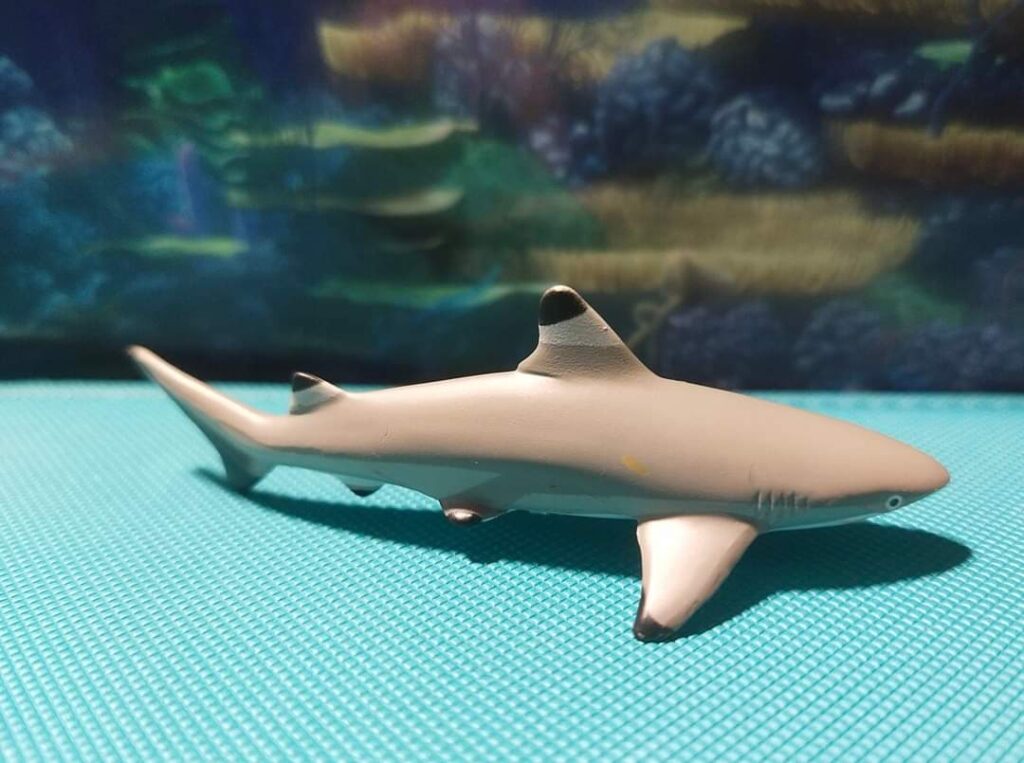
Blue shark (Prionace glauca)
Size of figure: 7.8 cm
Size of animal: 170-400 cm
Scale: 1:22-1:51
Species frequency in being made: uncommon
Preferred habitat: temperate and tropical waters in the open ocean, although it prefers cooler waters
Diet: fish, other sharks, squid, pelagic crustaceans, sea birds
IUCN status: Near Threatened
The most widespread pelagic shark, this species gets its common name from its bluish color. Despite their appearance and similarity to the mako sharks, they are unrelated, and the blue shark is classed as a requiem shark rather than a mackerel shark. The figure itself is rather slender with the blue color that gives the fish its name. Before the white underbelly and on the pelvic fins, there’s a bluish green streak dividing the counter-shaded blue and green which I thought was weird, as pictures I’ve seen of the shark show the dividing streak more of a greyish color. The pose looks somewhat static. Despite being among the larger species in the set, it is one of the smallest figures. In fact, the blacktip reef shark figure is larger than in when in reality, the blue shark can get twice the length of the reef shark and weigh heavier. A minor nitpick, but at the same time this could be a younger blue shark. The figure features a tail keel also, similar to lamniforms although not as pronounced. Another odd detail is that I wish the figure had a more metallic sheen to it, as it should being an open water species. This species has been made by Safari Ltd., twice by Schleich (but both retired), Bullyland, as well as a small figure made by Yowie Group. There looks to be a factory error on my figure, as a flake of plastic is obscuring one of the gill slits of this figure, which made me think it has 4 slits at first until I took a look at the other side, which has 5.
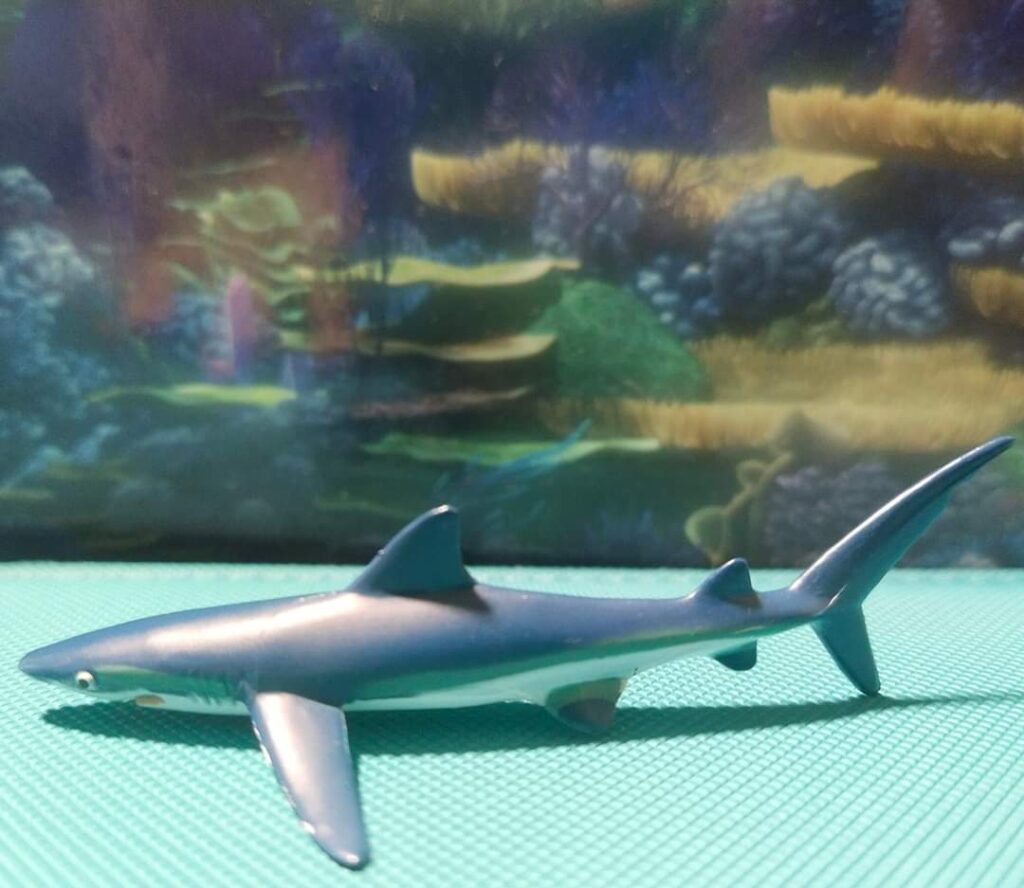
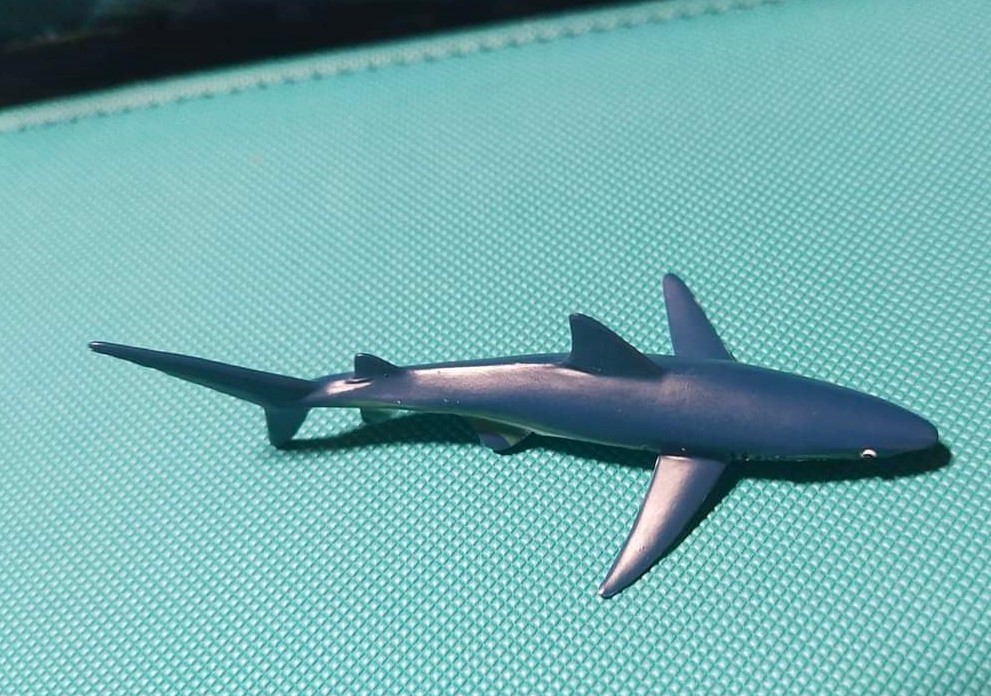
Bowmouth guitarfish (Rhina ancylostoma)
Size of figure: 7.8 cm
Size of animal: 150-300cm for a mature specimen
Scale: 1:19-1:39, although 1:10-1:15 is more appropriate as it resembles a sub-adult specimen
Species frequency in being made: Rare
Preferred habitat: Coastal areas and coral reefs
Diet: small fish, crustaceans, and mollusks
IUCN status: Critically Endangered
An unmistakable species, the bowmouth guitarfish seems to be the most represented guitarfish, and among the most popular ray figures, to be made, likely due to it also being known as the shark ray. A popular species in public aquariums, it has been known to successfully reproduce in captivity, which it is to be hoped will help the struggling wild populations. The figure is painted in with an olive brown main body and a white underbelly with a darker brown mid-body with darker grey spots on the face and white spots on the lower half on the belly. Adults are a paler greyish to grey-brown color while younger fish are a darker brownish-grey with darker patches as seen on the figure. The figure seems to be lacking in the ridges on the eyes which is typical of the species. They are, however, faintly present on the back of the head, although they could be more pronounced. The eyes are just a simple white with black pupils, like most figures in the set, but the real animal has a more ‘u-shaped’ pupil. Aside from the minor inaccuracies, the other key features are present: a keel on the tail, 5 gill slits, the nostrils, a weirdly-shaped mouth on the underside, spiracles on the top near both eyes, and a flattened underside akin to rays. The species has been also made by Kaiyodo, Safari Ltd. (a juvenile), CollectA, and Schleich.

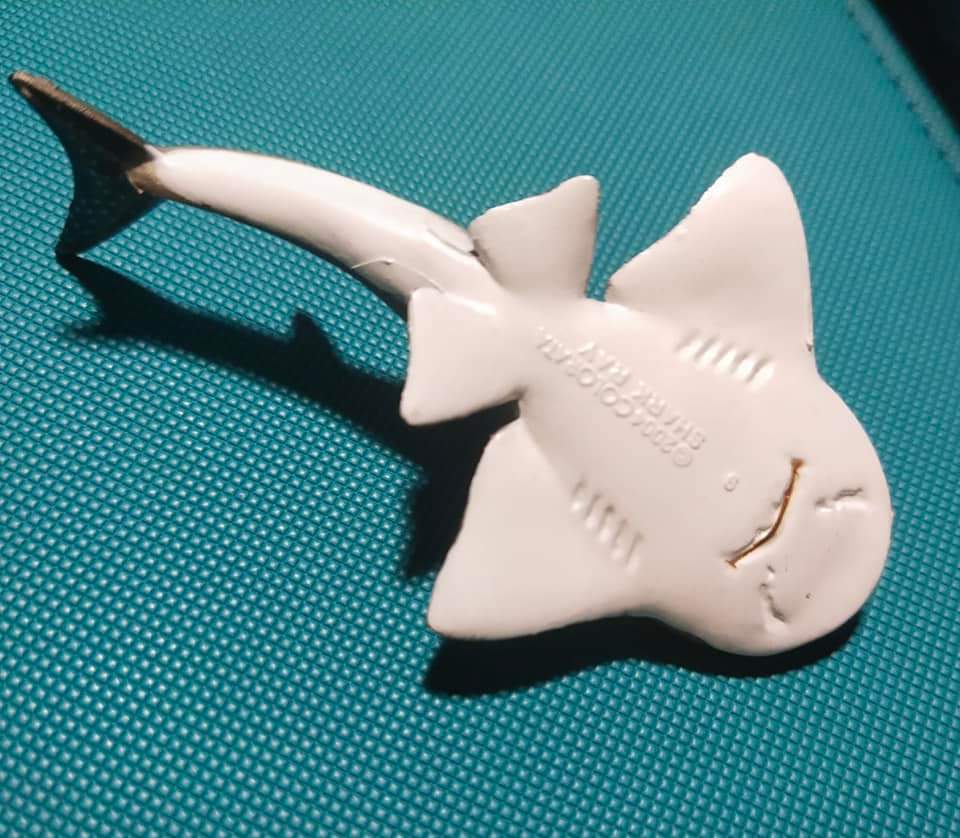
Great white shark (Carcharodon carcharias)
Size of figure: 10.6 cm
Size of animal: 450-640 cm
Scale: 1:43-1:60
Species frequency in being made: Very common
Preferred habitat: Coastal and offshore waters in the open ocean, usually far from land
Diet: bony fish, other sharks, rays, cephalopods, pelagic crustaceans, small cetaceans, pinnipeds, sea birds, carrion
IUCN status: Vulnerable
Arguably the most popular fish species, it needs no introduction. Despite their fearsome appearance, humans are not on the menu of this megafish. Most attacks are done by younger, inexperienced sharks that can’t tell humans apart from their preferred prey. The figure is the second largest in the set, fitting for the largest predatory fish alive today. The figure is painted with a dark grey top with a white underbelly, with a lighter grey boarder separating the dark and light parts of the body, as well as with a very dark grey highlight on the first dorsal, caudal, and pectoral fins and on the tip of the pelvic fins; however, black tips are absent on the pectoral fins. The gill slits are appropriately tall for the species and there is a lateral keel which I feel is well pronounced. The snout is appropriately pointy, with the eyes being fully black. The teeth are not individually sculpted, but for a figure this small and for the time that this figure is made, it’s rather forgivable. It is far superior to the Wild Republic and Safari Ltd. miniatures, although it’s facing rough competition with its updated counterpart from the newer shark box, Safari’s updated TOOB shark, and the Kaiyodo Choco Q figures. As this species has been made countless times, the figures of this species that are accurate are Schleich’s 2013 and 2018 figures, Safari’s 2016 Wild Safari Sealife and 2019 TOOB figures, Colorata’s Sharks of the World Deluxe box set and museum models, and the Papo version (as well as the Papo megalodon that does feel more like a great White shark figure).
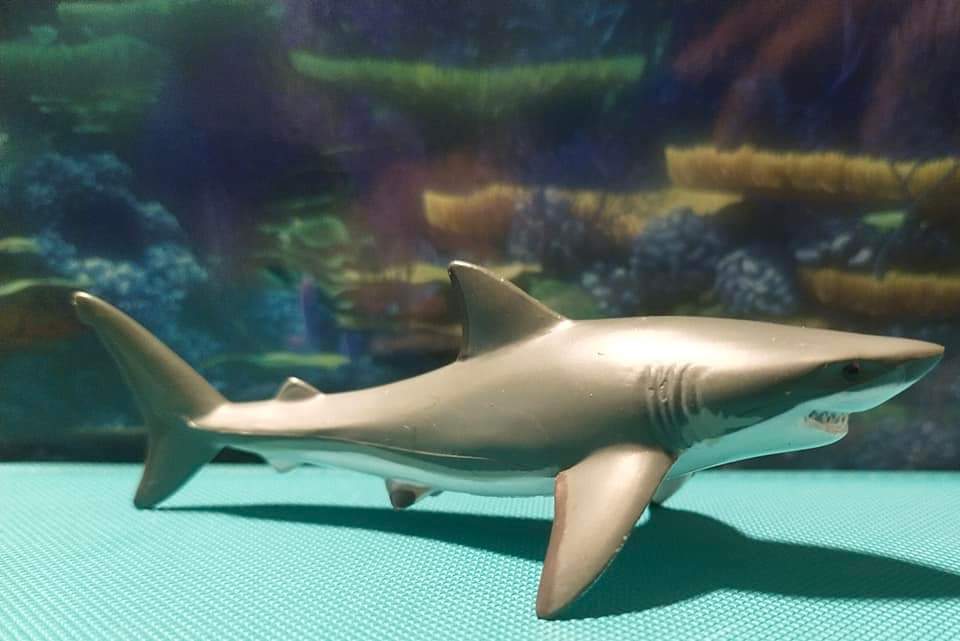

Japanese bullhead shark (Heterodontus japonicus)
Size of figure: 7 cm
Size of animal: 69-120 cm
Scale: 1:10-1:17
Species frequency in being made: rare
Preferred habitat: near the shores of continental shelf, around rocky reefs
Diet: small fish, crustaceans, mollusks, and urchins
IUCN status: Least Concern
One of the very few bullhead shark species made, with the zebra bullhead being made by Play Visions and the Port Jackson being made by K&M International, it is a welcome addition! Curiously, the name of this species translates to catshark in Japanese, which is odd considering bullhead sharks and catsharks have almost nothing in common. The figure is in a resting pose since this species doesn’t swim much; however, the body is slightly bent. The figure features the cutesy mouth which, despite the appearance, is well adapted to crushing hard-shelled prey, and is painted black in this figure. The color scheme comprises of a chocolate brown main body and a white underbelly with reddish brown bands ending in a cream color, which I feel should’ve continued around the width of the figure instead of breaking it up at either side of the body. The gill slits are hard to pick out, however. There’s grey outlines on all the fins and the iconic dorsal spines are included, but I wish they were painted and cut slightly from the dorsal fin to separate the fins and the spines. The eye should be u-shaped, but at least the pupil is oval rather than a generic circular pupil. The tail seems a little odd, even for this species. It should have a larger surface area than what’s seen in the figure. Still a cute little figure, and obscure sharks are always welcome! Other figures of this species includes the 2002 Ocean Kingdom version by Colorata (which I feel the newer one is a downgrade), Takara Tomy (a juvenile) for their shark gashapon set, Eikoh for their Miniatureplanet line, and For Corporation for their Aquarium Exclusive shark set.
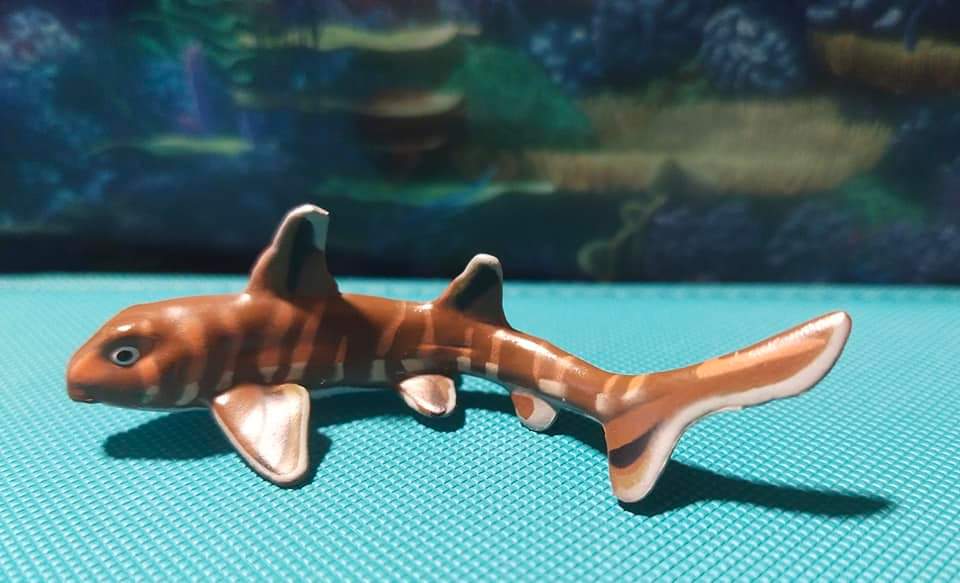

Leopard whipray (Himantura undulata)
Size of figure: 4.9 cm wide and 10 cm long
Size of animal: 80-130 cm wide and 410 cm long
Scale: 1:16-1:26
Species frequency in being made: unique
Preferred habitat: inshore waters with soft substrate, sandy and muddy flats, lagoons, brackish estuaries, and mangrove swamps
Diet: benthic fish and crustaceans
IUCN status: Endangered
Also known as honeycomb whiprays, the genus Himantura originally comprised of a single species. Further research suggests that there are now 3 separate species of leopard whiprays, despite being similar in size, shape, and color. I am unsure of the exact species of this figure, thus I’ve placed it as the originally described species, H. undulata. They get their name from the leopard-like spots on the back and the really long tail. These days they are relatively common in public aquariums; however, there isn’t another figure of this large impressive ray made by another company. I feel this figure is the weakest in the lot, as outside of the accurate whip like tail, accurate white underbelly with the right amount of gill slits, proper placement of the nostrils and mouth, presence of a stinger (that is blunt but can be forgiven due to safety), as well as the correctly-shaped eyes and the spiracle opening behind either eyes, the other main distinguishing features could have be executed a lot better: the figure should be flatter, the wing like fins should be more diamond-shaped rather than circular, the eyes are sloppily painted giving it a generic circle eye (instead of oval eyes with a u-shaped pupil), the spots should be brown rather than black (but at least they got the leopard-like spots right), and the yellow main body should be more of a golden brown color based on the pictures and specimens I’ve seen. A unique species with a more-to-be-desired execution and I hope a company can give this large ray justice with a definitive standard-sized figure.
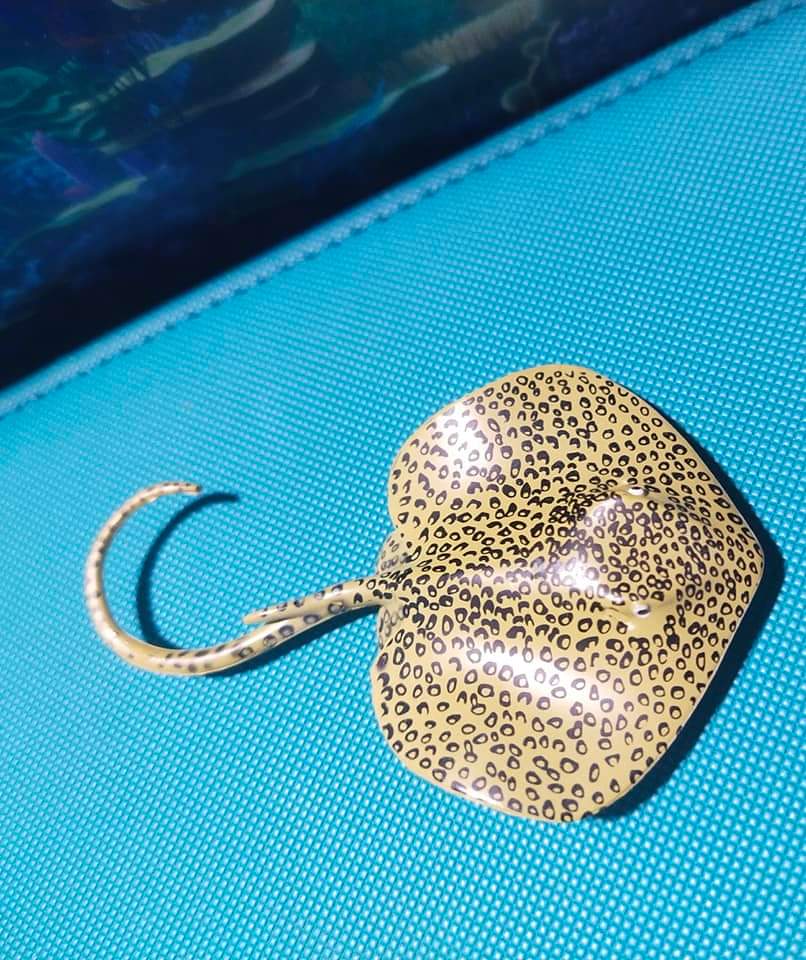
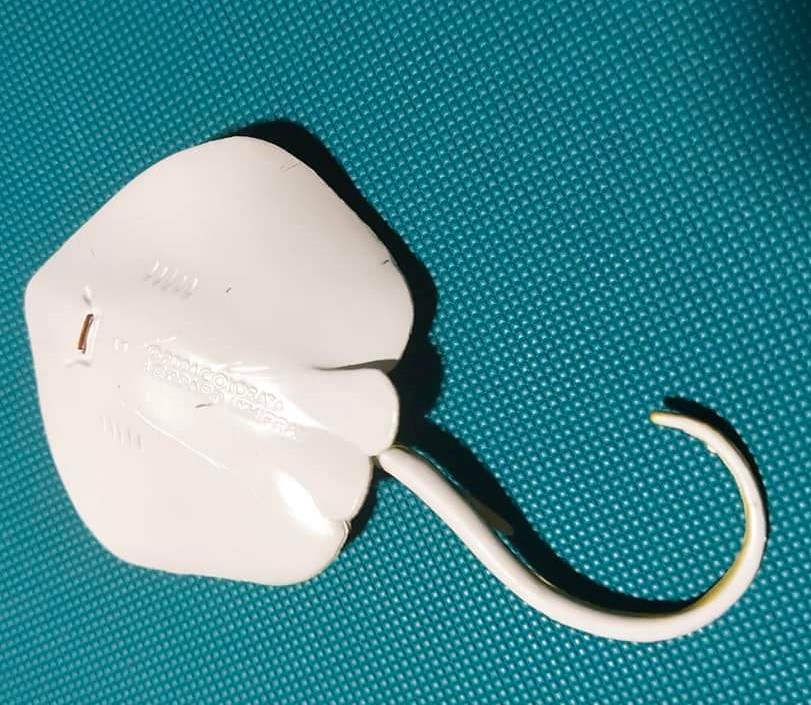
Reef manta ray (Mobula alfredi)
Size of figure: 8.9 cm wide, 8.8 cm long
Size of animal: 370-550 cm wide
Scale: 1:41-1:61
Species frequency in being made: Rare
Preferred habitat: Coral and rocky reefs, coastlines, tropical island groups, lagoons and atolls
Diet: zooplankton and other microorganisms
IUCN status: Vulnerable
Mantas are the most recognizable and most commonly-made rays in figure form, being featured in almost every single figure line that has a ray in it. What many people don’t know, is that there are 2 distinct species of manta: the reef manta (Mobula alfredi) and the giant oceanic manta (M. birostris). This figure is based on the reef manta due to the lack of a vestigial stinger, scattered black ventral spots extending past the gills, smaller gill-to-body ratio, and the shoulder markings being a ‘y-shape’; however, all features will have exceptions between both species, except the vestigial stinger being an indicator of the giant oceanic manta. These rays have the largest brain-to-body ratio of any marine fish and thus are very intelligent, even being capable of self awareness. This figure is appropriately the largest of the rays in the set and among the larger figures in the set, alongside the tiger shark, great white, and whale shark. The main body is a very dark grey, almost black, color with a lighter grey shoulder markings and other patterns on the top, which would be unique to every individual, like human fingerprints. The underbelly and the trademark cephalic fins are a glossy white and the interior of the mouth is a dark grey color. It’s also worth noting that this figure scales well with the 2018 Safari Ltd. giant oceanic manta ray, which does help provide a tool in educating between the two species. Colorata has made a reef manta for their Museum Model line; however, while the colors is in line with the reef manta, the vestigial stinger supports an ID of a giant oceanic (maybe it can be seen as a hybrid). CollectA, Schleich (2013), and Eikoh have since made reef mantas; to my knowledge the others are either giant oceanic or generic mantas.

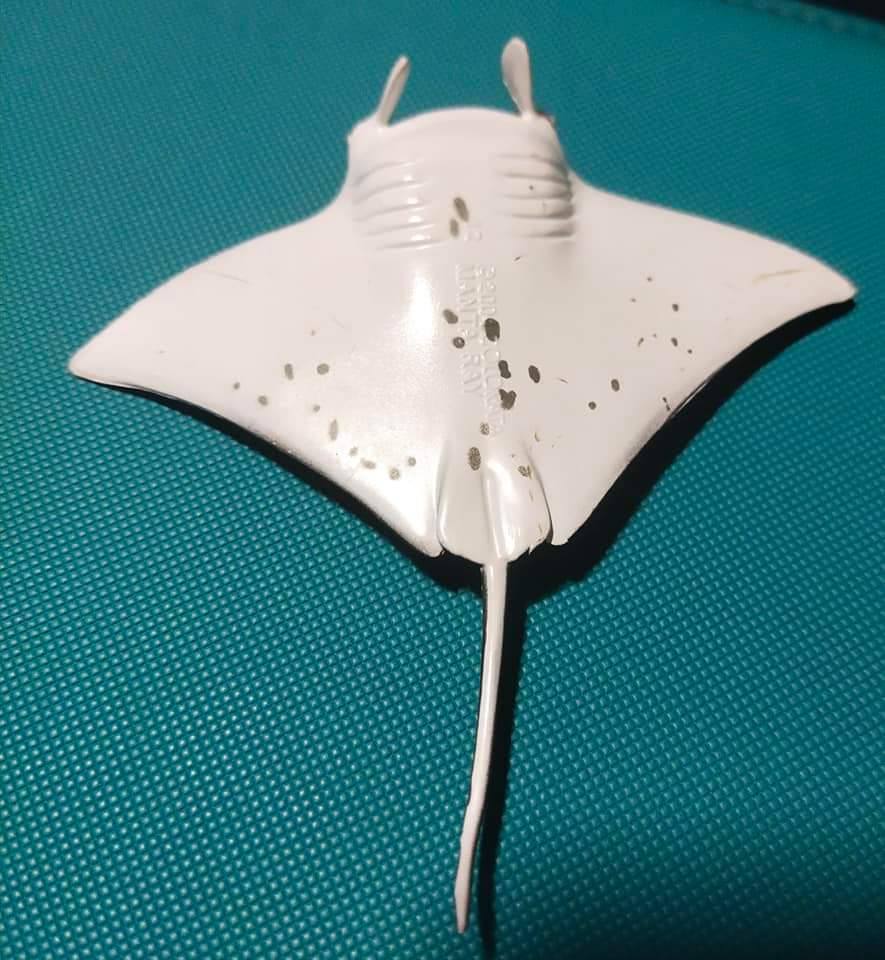
Sand tiger shark (Carcharias taurus)
Size of figure: 9.2 cm
Size of animal: 220-330 cm
Scale: 1:24-1:35
Species frequency in being made: rare
Preferred habitat: inshore waters around reefs, bays, and near the continental shelf
Diet: bony fish, other sharks, rays, squid, crabs and lobsters
IUCN status: Critically Endangered
Perhaps the most popular large shark in public aquariums due to its hardiness, it is an appropriate figure to be featured in this set. Despite its fearsome appearance, this shark is docile unless provoked. This species is the only known shark to gulp air on the surface, which helps it float mid water without using too much effort to swim in order to stalk prey. The figure itself is my favorite in the entire set, as I remember being terrified of these sharks at the aquarium when I was little. I’ve learned to marvel at these beautiful and misunderstood creatures. The figure is painted brown on the top which is metallic akin to the later Safari Ltd. model, which I adore, with a white underbelly and greyish brown to divide the brown from the white. The teeth are not individually sculpted, as it is hard to replicate the needle-like teeth. There are grey spots scattered along the mid section, although some are too large, and there’s a grey tip/outlines on all fins. The pupil of this shark could be smaller to give it a more menacing appearance; however, key features like the 2 dorsal fins being almost the same size and rather short gill slits seal the deal of this being my favorite. Bullyland, Kaiyodo, Maia & Borges, and Safari Ltd. have all made figures of this shark.

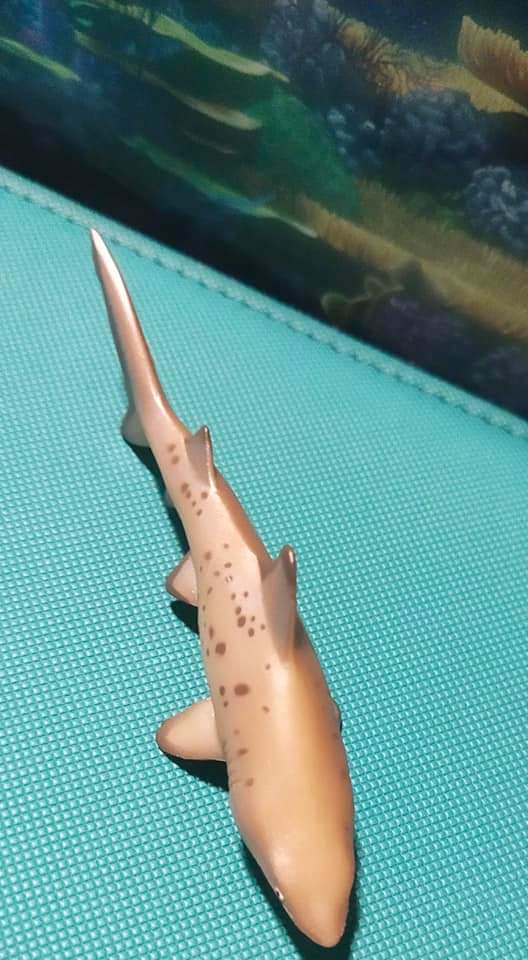
Scalloped hammerhead shark (Sphyrna lewini)
Size of figure: 9.2 cm
Size of animal: 140-430 cm
Scale:1:15-1:46
Species frequency in being made: Uncommon
Preferred habitat: Coastal warm temperate and tropical waters
Diet: bony fish, cephalopods, crustaceans, other sharks, rays
IUCN status: Critically Endangered
Arguably the most recognizable shark due to the strange looking head, which despite its odd appearance, is a very effective tool in helping it hunt its favorite prey: stingrays. Scalloped hammerheads are distinguished by the bumps on the head, resembling a kidney, as well has having a more rounded and blunt first dorsal fin. These sharks have very complex and large brains with high levels of cognitive abilities, social intelligence, sensorimotor functions, intricate migrations, complex habitat relationships, and athletic capture of prey, which aids them in their schooling behavior and is not given credit due to the general public fearing sharks. While hammerheads are commonly made, it’s always the big 3 that gets made: scalloped, great and smooth, and since all 3 have very distinct physical features, getting exact species is hard as they may be a chimaera at times. The scalloped hammerhead so far has the most figures and toys while the smooth has the least out of the big 3. The figure is painted in a metallic bronze color which real scalloped Hammerheads can have, along with greyish brown or gray. The underbelly is white and the pectoral fins feature the typical black tips present in many sharks. There are grey highlights on the dorsal and pectoral fins and a darker grey on the bottom of the caudal fin. He head is appropriately shaped with the kidney-like ridges, which allow it to be identifiable as a scalloped hammerhead, and the mouth is low slung. The pectoral fins are appropriately wide like in the real fish, and the dorsal fin is rounded and the caudal fin is long. Among the best executed in the set. The scalloped hammerhead has been made by Colorata previously in the Ocean Kingdom set, Kaiyodo, Papo, CollectA, Favorite Co., and Schleich as a Happy Meal toy, which seems to be a modified version of their great hammerhead; Papo one is easily the best out of the bunch.
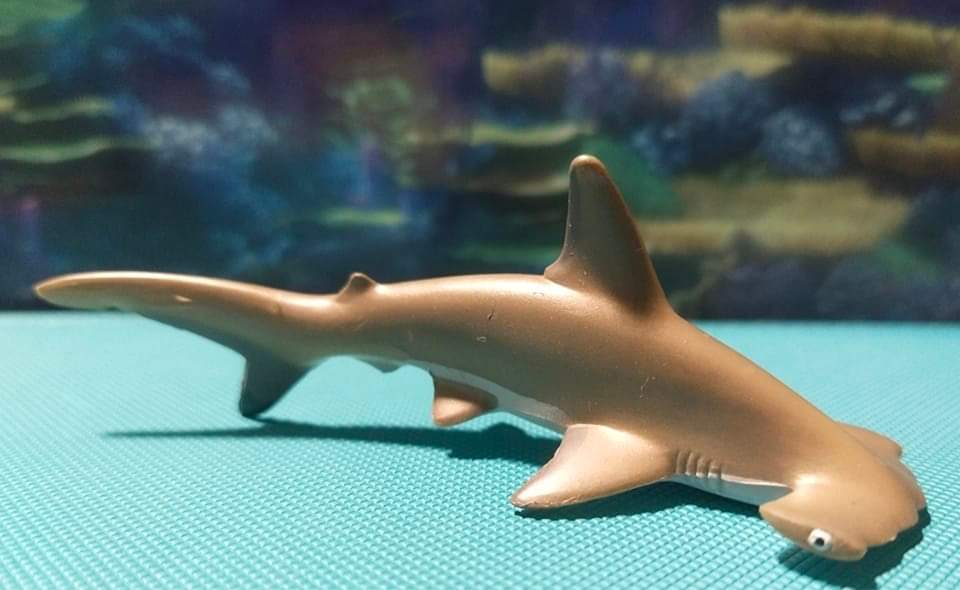

Spotted eagle ray (Aetobatus narinari)
Size of figure: 5.4 cm wide, 6.6 cm long
Size of animal: 110-230 cm wide
Scale: 1:20-1:42
Species frequency in being made: uncommon
Preferred habitat: coastal habitats, reefs
Diet: mollusks, crustaceans, and small fish
IUCN status: Endangered
Like the manta rays and leopard whiprays, the spotted eagle ray was originally considered a single species, until more thorough research has suggested there are 3 species divided by the geographical ranges. For simplicity, I’m going to identify this is the original described species, Aetobatus narinari. These rays are a common sight in public aquariums, especially when the system isn’t sufficient to house the mantas or other Mobula species. Not counting rays from the Mobulidae or the sawfish, these rays are the largest, especially A. ocellatus which can have a wingspan up to 300 cm and a body length 500 cm long including the long whip-like tail. A. narinari and the other species A. laticeps max out at a smaller yet impressive 230 cm wingspan. In the accuracy department, this little figure ticks off a majority of the boxes: the iconic duck-like bill rostrum, an accurate color scheme of a black top of the main body and tail with a white underbelly with grey tips on the pectoral fins, the smallish eyes with the ray spiracles behind either eyes (although the eye paint is sloppy on this figure), the mouth and nostrils are the correct shape with a weird w-shape for the mouth, the gill slits are appropriately tiny for this species, as as is the tiny dorsal fin, and the inclusion of a stinger at the end of the tail (which is obviously shortened but does look like it unless you’ve measured it). Minor complaints in terms of accuracy are that there should be more white going past half of the height of the eyes and I do wish the figure was bigger with a larger wingspan. This figure features many features that other figures of this species fail to recreate. Other figures of this species include those by Kaiyodo for their Aquatales line, Safari Ltd. (which has the wrong color scheme, only 4 gill silts, and the body needing to be more flattened), Mojö Fun (which lacks a dorsal fin and the pelvic fins are way too big and the pectoral fins are way too thin; also this figure is a better representative of M. ocellatus), and Kitan Club (a weird standing but rather accurate figure). There is an enlarged version of this figure although some features do not translate well during enlargement, and I really wish a company would just make a definitive standard-sized spotted eagle ray figure.
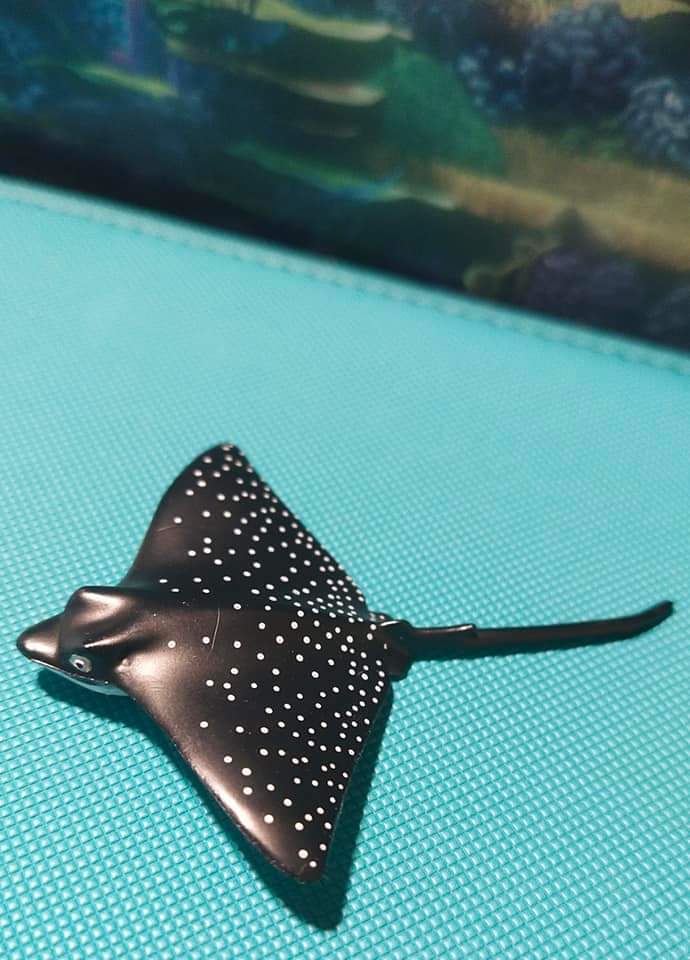
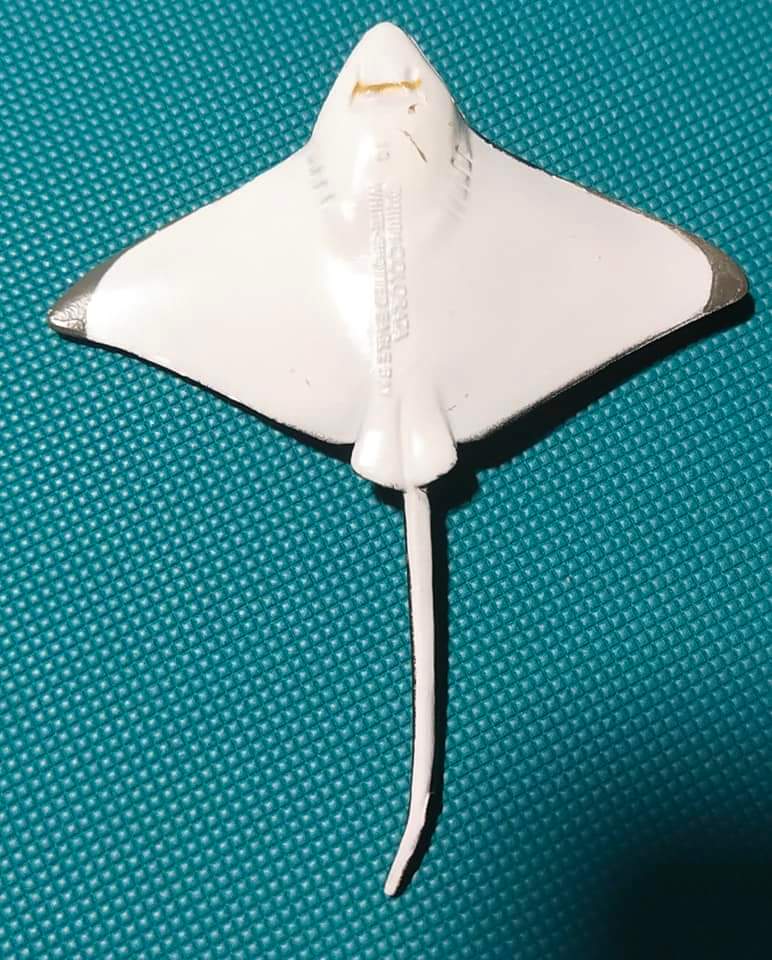
Tiger shark (Galeocerdo cuvier)
Size of figure: 10.1 cm
Size of animal: 210-500cm, may be up to 750 cm (although unconfirmed)
Scale: 1:20-1:49, 1:74 for the unconfirmed 750 cm estimate
Species frequency in being made: common
Preferred habitat: tropical and temperate waters
Diet: widest food spectrum of any shark, including bony fish, other sharks, rays, cephalopods, crustaceans, jellyfish, sea turtles, sea snakes, dolphins, pinnepeds, seabirds, and inanimate objects like license plates and other human garbage thrown into the ocean
IUCN status: Near Threatened
The largest of the requiem sharks (the great hammerhead is longer but doesn’t reach close the same weight as the tiger shark). The shark got its name from the tiger-like stripes, which are more prominent in juveniles and fade as the shark ages. They are more likely to bite humans due to their curious nature of test biting out. They are an uncommon species in public aquariums due to their large size and aggressive nature, especially to smaller animals. The Georgia Aquarium houses these sharks and the Okinawa Aquarium has been able to breed them successfully. The figure itself is painted with a gray main body with a brownish-gray highlight and vertical strips, which would suggest a sub-adult or an adult specimen, and a white underbelly. The stripes extend past the gills and end on the top of the caudal fin and there are dark gray highlights on all fins. The mouth is open; however, the teeth are not individually sculpted. I do wish the dorsal fin was a tad shorter as tiger sharks have more of a short and wide dorsal fin rather than a taller one. Colorata got the larger top of the caudal fin right as they’ve sculpted the low keel on the base of the tail. I do feel the snout is a bit too sharp as tiger sharks have squarish snouts, and this makes the figure look like an oversized bull shark. Also, the anal fin should be a tad bigger as in life (the Safari Ltd. TOOB tiger shark has this feature better executed), as it should be as large as the second dorsal fin. I would prefer the eye to be all black like the great white as the eye looks too derpy on this figure. Other figures of this species include those by CollectA, three by Safari Ltd. (the aforementioned TOOB figure, Wild Safari Sealife, and Monterey Bay Aquarium), two retired versions by Schleich, an updated figure by Colorata for their Deluxe Sharks of the World box, Kaiyodo (Capsule Q Museum Okinawa Wildlife set), and Chap Mei (only the decent and accurate ones are mentioned).
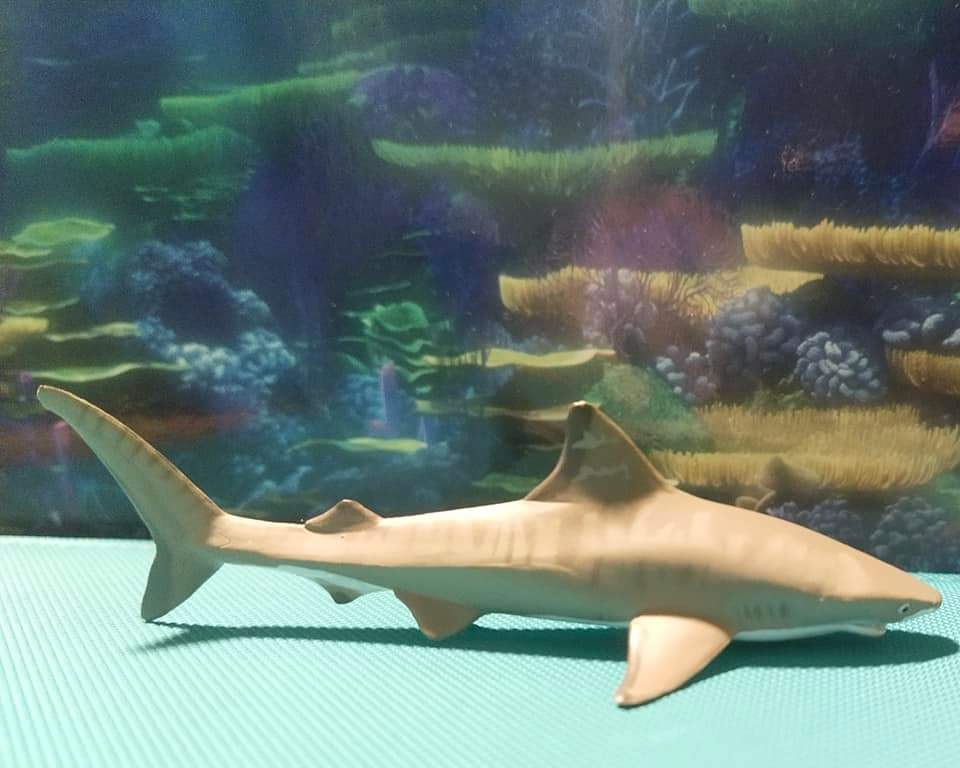
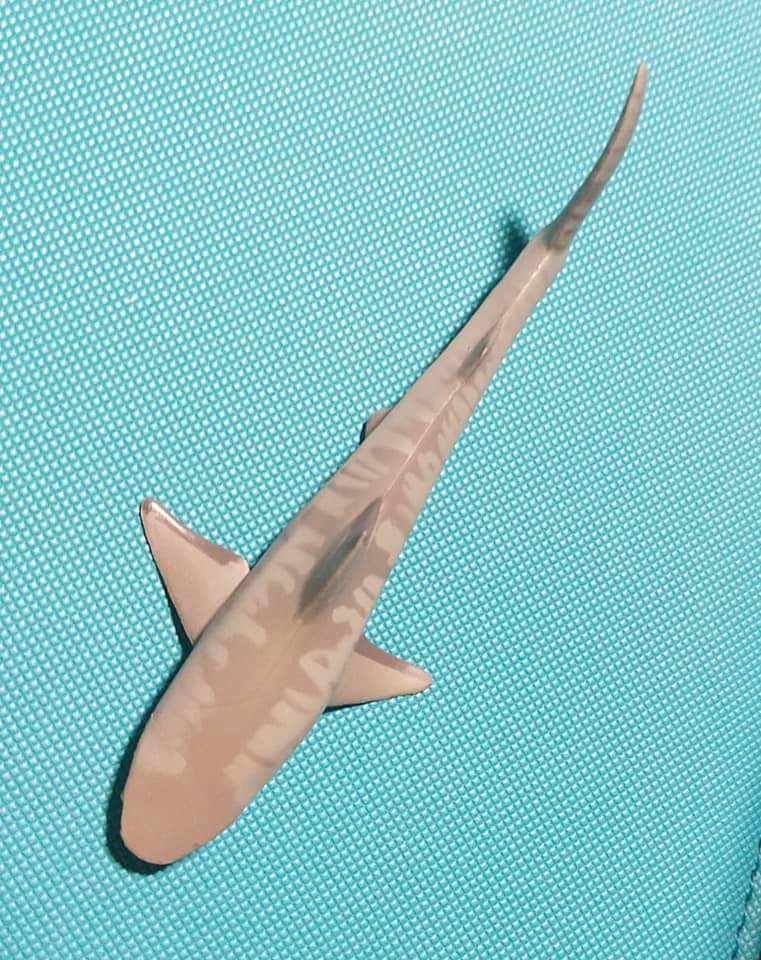
Whale shark (Rhincodon typus)
Size of figure: 12.7 cm
Size of animal: 900-1200 cm for a typical mature female, unconfirmed reports of 2000 cm females
Scale: 1:70-1:94, 1:157 for the giant 2000 cm reports
Species frequency in being made: Common
Preferred habitat: Tropical and warm temperate oceans, near reefs and in the open ocean
Diet: Small fish, fish eggs, zooplankton, krill, jellyfish
IUCN status: Endangered
The largest animal alive today that isn’t a whale, it is fitting that the whale shark is the largest figure in the set. Despite this, they are harmless to humans unless when near their powerful tail, and have been successfully kept in aquariums large enough to house this fish, including the Georgia Aquarium and the Okinawa Aquarium. This whale shark is painted with a bluish main body with a white underbelly. Real whale sharks are bluish, greyish, brownish, or even black, so the color scheme works. The iconic checkerboard patterns comprising of vertical stripes and spots of different sizes scattered from head to the tail are painted in a bluish color from the head to the gills while they are painted a greyish color for the rest of the body. The head is the correct squarish shape when viewed from the top. The mouth is partially open and the interior is painted in a pale pink color. The eye does look a bit too big, but then again this could be a younger individual, and there’s a spiracle sculpted behind the eye. The mid-body ridges are present and the fins look to be in the correct shape and proportions: the dorsal fins being somewhat rounded and the crescent-shaped tail to propel this large animal. Fortunately, there are no shortages of whale shark figures, despite not being the typical menacing predatory shark, including those by CollectA, Safari Ltd. (Monterey Bay Aquarium and Wild Safari Sealife models), Schleich, Maia & Borges, and Mojö Fun, Kaiyodo (several, although they are on the smaller side), Takara Tomy (with a black color scheme), and Papo (both a juvenile and adult, the latter of which is the best whale shark figure).

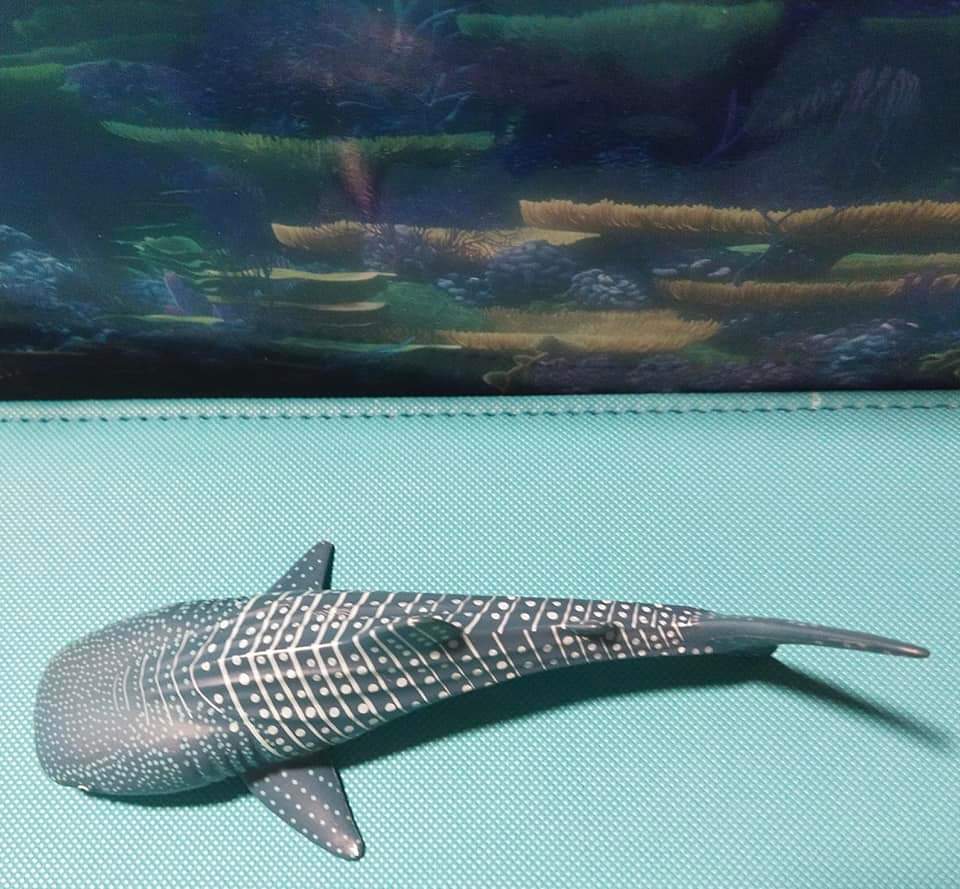
Overall, this is the best tube/box-style shark set for both children and adult collectors alike. Not only included are a large variety of sharks, but also various rays. This set is still in production after 18 years and while some designs may now be up to today’s (or to other Japanese figure) standards, overall the set is still comparable to Safari Ltd’s more recent TOOBs. The set retails for about 2750 yen, although it used to be cheaper (inflation is a thing). There has been an update to this set in the form of the 2011 Sharks of the World Deluxe box set, in which the great white, tiger, and whale sharks have gotten updated figures. The rest of set features less but more obscure species like deep sea sharks; however, the rays are omitted so I would rather get both sets together. That’s the end of the review and I hope you guys continue to educate yourselves and others about these majestic yet misunderstood beings and to respect and not fear them! I would like to give a shout out to fellow forum member Brett for helping me get this set via his proxy service earlier this year.
Disclaimer: links to Ebay and Amazon on the AnimalToyBlog are affiliate links, so we make a small commission if you use them. Thanks for supporting us!




Great review to wrap up the week. I like the leopard whiptail and Japanese bullhead the most.
Yes, I need to hunt down that Japanese bullhead; I don’t have that species yet. I do have the leopard whiptail and the reef manta from this set, however.
I’m glad you guys like the leopard whipray while I can’t really enjoy it haha
It’s mostly because it is the only one. Sometimes you just have to take what you can get.